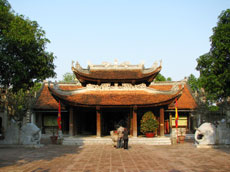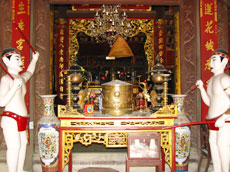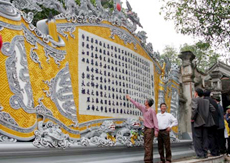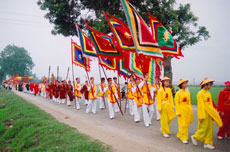Located in Dinh Bang Ward in Tu Son Town of Bac Ninh Province, about 15 kilometers from Hanoi, Do Temple or Ly Bat De Temple honoring the eight kings of the Ly Dynasty (1009 – 1225) in Vietnamese history has an important role in the spiritual life of Vietnamese.
 In fact the Ly Dynasty has eight kings and one queen, but the queen, Ly Chieu Hoang, the last of the dynasty, was worshiped at Rong (Dragon) Temple, two kilometers west of Do Temple.
In fact the Ly Dynasty has eight kings and one queen, but the queen, Ly Chieu Hoang, the last of the dynasty, was worshiped at Rong (Dragon) Temple, two kilometers west of Do Temple.
The Ly Dynasty originated in Dinh Bang (Co Phap) village, which known as one of three oldest villages in the North together with Co Bi and Co Loa.
According to “Dai Viet Su Ky Toan Thuâ€, a famous book about Vietnamese history written by many generations of Vietnamese historians during the feudal time, Do Temple was built in 1019 by the first king of the Ly Dynasty, Ly Cong Uan or Ly Thai To and was enlarged by his son Ly Thai Tong in 1030. The temple was used by Ly Thai To to meet the people to ask about their opinions on plans to safeguard the country.
Since then the temple has been altered several times. The major reconstruction took place under the reign of Le Trung Hung, in the 17th century. In 1952, the temple was destroyed by the war and was restored in 1989 as original temple based on old documents.
Formerly, the Do Temple was famous for its architecture, highly praised through the verses:
"The architecture of the Do Temple is marvelous,
Worthy to the thousand-year-old history of Thang Long"
The temple was built on an elevated area of land of 31,250 square meters. It is surrounded by high walls and more than 20 architectural works.
 In front of the temple lies a half–moon shaped lake, with clear and full water throughout the year. The lake is connected with two ponds at both ends of the village, with the Tieu Tuong River in front of the village. In the center of the lake stands a square house reserved for water puppetry performances with two beautiful tiered roofs. To the south of the lake, there is a huge pavilion to preserve stone slabs inscribed with the merits of the eight kings of Ly Dynasty, and to the north of the lake, a 5-compartment floating house for visitors to take a rest.
In front of the temple lies a half–moon shaped lake, with clear and full water throughout the year. The lake is connected with two ponds at both ends of the village, with the Tieu Tuong River in front of the village. In the center of the lake stands a square house reserved for water puppetry performances with two beautiful tiered roofs. To the south of the lake, there is a huge pavilion to preserve stone slabs inscribed with the merits of the eight kings of Ly Dynasty, and to the north of the lake, a 5-compartment floating house for visitors to take a rest.
The temple's gate, called Ngu Long (five dragons) gate, includes five doors made of hard wooden plates assembled together and carved on top images of dragons waiting upon the moon. When the door opens, its two leaves are wide apart, and the two dragons on top of the doors seem to be soaring. On day, the dragons' eyes when catching the light shine like gemstones. Along the three-step staircase, are carved two stone dragons with clouds around, on a green stone floor, symbolizing the Thang Long (Soaring Dragon) Capital.
Passing the gate and a large yard, a green stone paved road leads visitors to a square house (Phuong dinh), with eight tiered roofs and three compartments, 70 square meters in area.
Then to Tien Te House, a 7-compartment front worship house to worship the first king, Ly Thai To, 220 square meters in area, whose front walls are hung with two big posters displaying capital letters meaning "Eight Kings together brightening" and "Co Phap Commune - a foundation of the Ly Dynasty". Hanging on the left side of the house is the royal proclamation of the moving of the capital city from Hoa Lu to Thang Long (Hanoi) of King Ly Cong Uan. The proclamation has 214 words corresponding to 214 years of rule by the eight Ly kings, namely Ly Cong Uan or Ly Thai To (1009-1028); Ly Thai Tong (1028-1054); Ly Thanh Tong (1054-1072); Ly Nhan Tong (1072-1128); Ly Than Tong (1128-1138); Ly Anh Tong (1138-1175); Ly Cao Tong (1175-1210) and Ly Hue Tong (1210-1224). Hanging on the right side of the house is the  famous poem Nam Quoc Son Ha of Ly Thuong Kiet which is considered as the First Declaration of Independence of Vietnam.
famous poem Nam Quoc Son Ha of Ly Thuong Kiet which is considered as the First Declaration of Independence of Vietnam.
Come to next, the 180 square-meter Co Phap Dien shrine is the site of many relics including ancestral altars, the thrones and the statues of the eight kings and a shrine to worship the kings’ wives, among others.
Recently, in Do Temple Festival 2009, the Viet Nam’s biggest Royal Proclamation made of Bat Trang ceramic had been inaugurated and placed at the temple’s gate. The proclamation is more than 30 square meters in diameter. It consists of 214 Chinese characters. Each character is in dimension of 16 and 16 centimeter with the fine cobalt blue glaze. The origin of this royal proclamation, the Heaven Capital Proclamation, was written in 1010 by King Ly Thai To to explain the reason why he decided to move the capital city from Hoa Lu, Ninh Binh Province to the present Thang Long – Hanoi site. It is one of many events and activities taking place in Do Temple to commemorate 1,000th anniversary of the coronation of Ly Cong Uan in 2009 and being directed toward the 1,000th anniversary of Thang Long – Hanoi in 2010.
 Do Temple are attracting a lot of people who come to understand more about the history of Viet Nam or look for the root as well as contemplate its distinctive architecture. A traditional Do Temple Festival annually celebrated by the locals on the 14th to the 16th days of the third lunar month to commemorate the coronation of Ly Cong Uan and to pay homage to kings of the Ly Dynasty, also attracts thousands of pilgrims every year.
Do Temple are attracting a lot of people who come to understand more about the history of Viet Nam or look for the root as well as contemplate its distinctive architecture. A traditional Do Temple Festival annually celebrated by the locals on the 14th to the 16th days of the third lunar month to commemorate the coronation of Ly Cong Uan and to pay homage to kings of the Ly Dynasty, also attracts thousands of pilgrims every year.
Phuong Anh (Collected)